While it is the tenth-largest state in the United States in terms of land area, Wyoming is also the least populous. With so much land and so little urbanization, much of the landscape remains wild, including its forests.
The average elevation of Wyoming is over 6,000 feet above sea level, so the majority of the state’s forests are coniferous. But, whether it’s the sprawling evergreen forests or the pockets of hardwoods in the state, Wyoming is truly an arboreal paradise. Here are nine magnificent trees that are native to The Equality State.
1. Whitebark pine (Pinus albicaulis)
A mature whitebark pine usually looks gnarled and twisted due to the harsh conditions it grows in. The tree grows in rocky, nutrient-poor soil and is often found in regions with severe weather swings. The subalpine areas where the whitebark pine grows can be assaulted with snow, ice, and hurricane-force winds in the winter, and then go through bone-dry summers. If we lived in those conditions, we’d look a little gnarly, too!
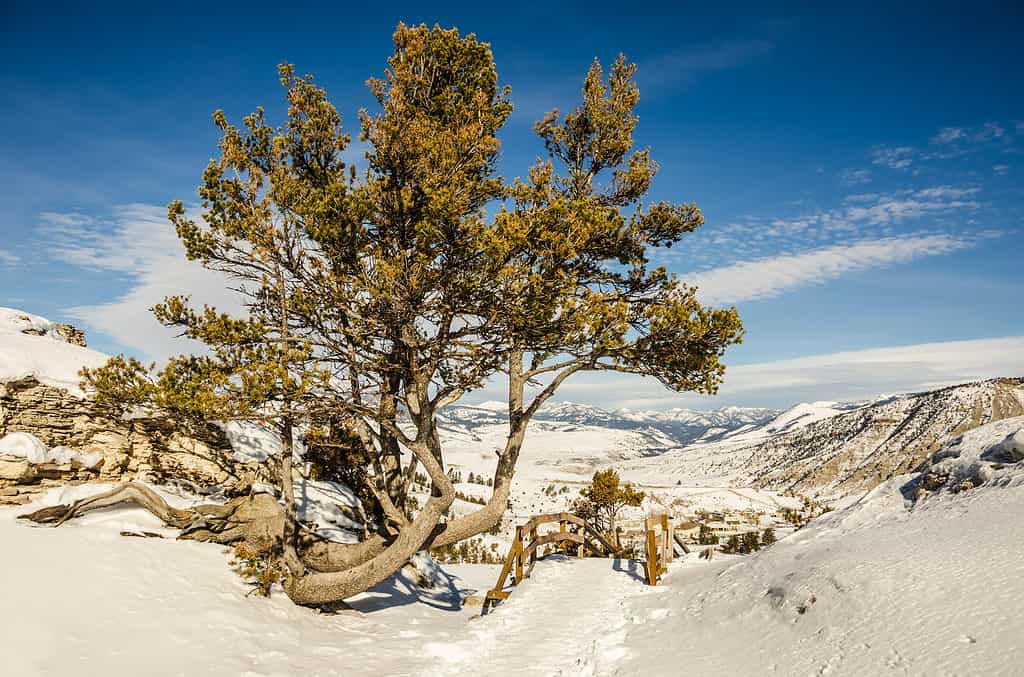
©Sue Smith/Shutterstock.com
The tree can grow to heights of 60 feet, but will also feature much more stunted growth at higher, windier elevations. In the highest altitudes, a whitebark pine tree more closely resembles a shrub.
The proliferation of the whitebark pine relies very heavily on the Clark’s nutcracker, a bird that collects and stores the seeds of the whitebark pine in caches that can number over 90,000 seeds. Some of those seeds will remain uneaten and will sprout.
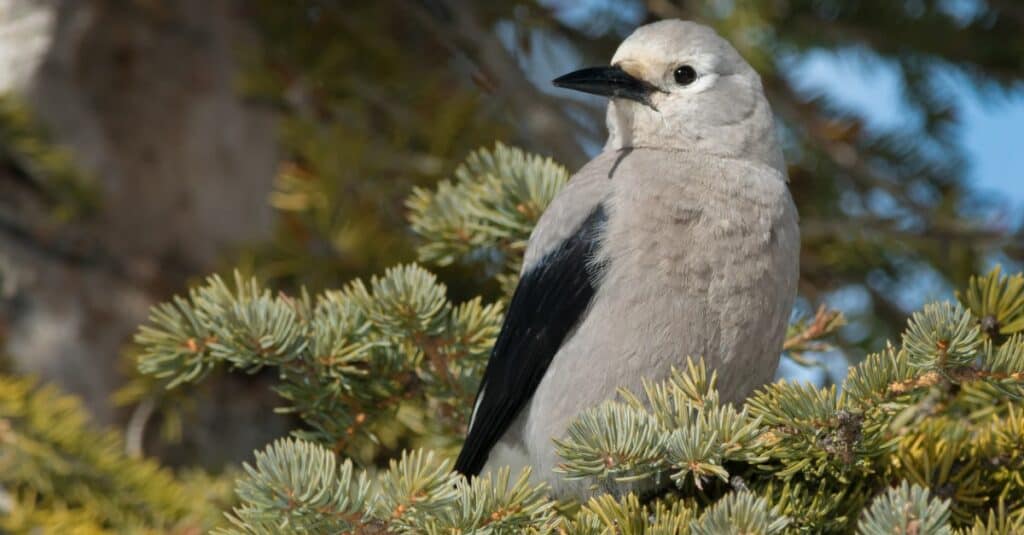
©iStock.com/PaulReevesPhotography
When a seed does take root, it takes 60 years or more to reach peak cone production. But, while the tree doesn’t grow quickly, it does grow for a long time. Some have been estimated to be over 1,000 years old!
The future of this gnarled beauty is uncertain, though. In December 2022, the U.S. Fish and Wildlife Service announced that the whitebark pine would be listed as a threatened species under the Endangered Species Act. Fire, the proliferation of the mountain pine beetle, and the white pine blister rust fungus are all contributing factors to the tree’s decline.
2. Quaking Aspen (Populus tremuloides)
Colloquially known as “Quakies,” the quaking aspen’s name comes from its leaves that are connected to the branches with long and flat stems (petioles). With this structure, a passing breeze will make all the leaves flutter and the entire tree will look as if it is trembling or quaking. It’s quite a sight to see a full-grown quaking aspen, which can reach heights of nearly 100 feet, trembling in the wind!

©Colin D. Young/Shutterstock.com
Like all aspens, the bark of the tree is white with black spots. The spots are scarring where branches have fallen off as the tree naturally prunes itself.
In the spring, the quaking aspen produces catkins, which are long, thin clusters of tiny flowers. These catkins then turn into small seeds with a cottony appearance that are blown by the wind, similar to how a dandelion’s seeds are spread.
The leaves are a deep green during the summer, but during autumn, they explode in a bright, golden yellow display. This annual color display has made it a popular ornamental tree for gardeners.
Dense colonies of quaking aspens can be found growing wild, especially in the Rocky Mountains of western Wyoming.
3. Ponderosa Pine (Pinus ponderosa)
The signature dark-green needles remain on the ponderosa pine tree year-round. When viewed at a distance, though, a ponderosa pine forest doesn’t appear green, but black. This gave rise to the name Black Hills, an area of forested hills and mountains in western South Dakota and northeastern Wyoming.
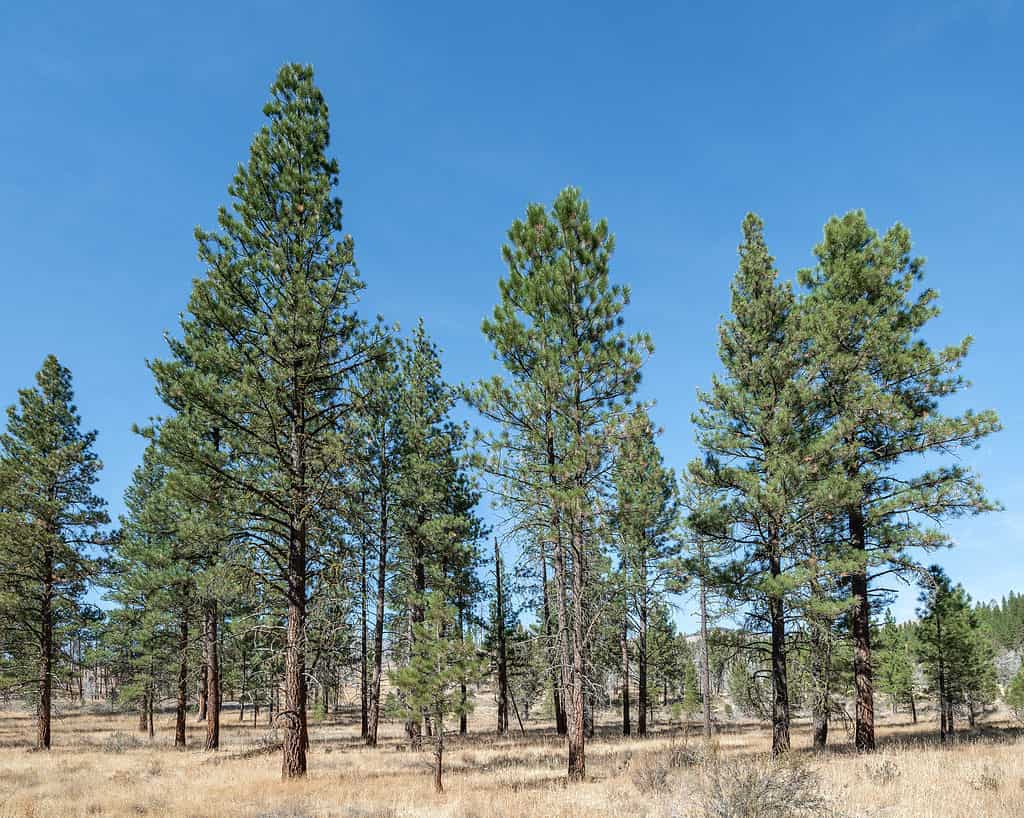
©Dominic Gentilcore PhD/Shutterstock.com
This tree is known by multiple names. The ponderosa pine is also referred to as the bull pine, blackjack pine, and western yellow pine. Regardless of what you call it, this conifer is a long-lived giant that can reach towering heights of over 200 feet and live upwards of 300 years. It features thick rust-colored bark that breaks into large plates. The plates are separated by black crevices, hence the blackjack pine moniker.
The tree also has a distinctive fragrance similar to butterscotch or vanilla. Strolling through a ponderosa pine forest is a treat for all the senses!
Ponderosas naturally self-prune their lower branches. This, coupled with the thick bark and sap, make them resistant to fire. Even if all the needles are burned off in wildfire, the tree will often survive as the vital phloem layer is protected by the thick, armor-like bark.
4. Plains Cottonwood (Populus deltoides subsp. monilifera)
Declared the official state tree of Wyoming in 1947, the plains cottonwood is the iconic tree of the American prairies. The cottonwood name refers to the cotton-like fibers that surround the tree’s seeds. These catkins (commonly known as the “cotton”) are released in early June.
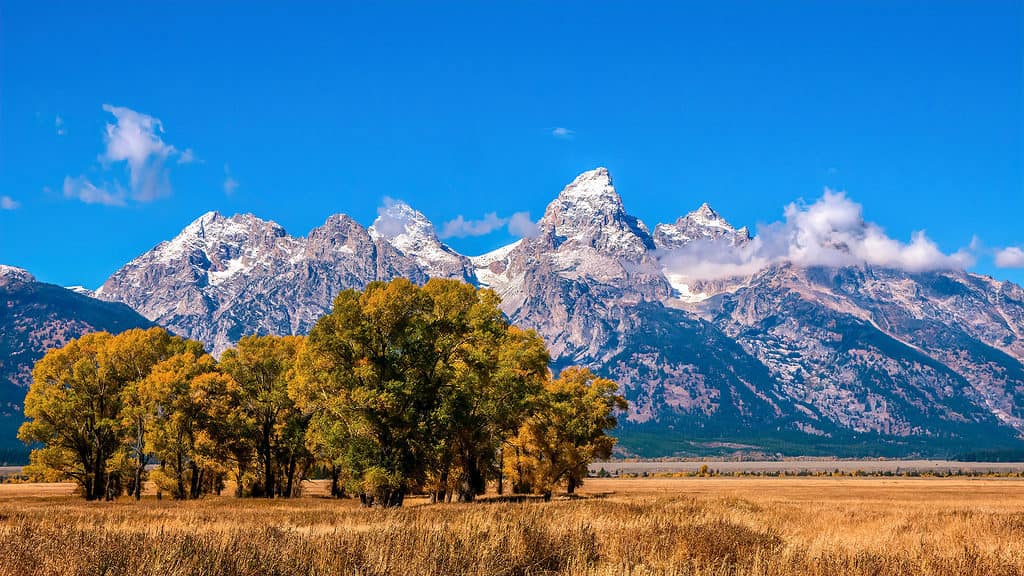
©CherylRamalho/Shutterstock.com
This fast-growing tree can grow nearly six feet in a single year, topping out at a maximum height near 100 feet, with a trunk measuring up to five feet in diameter and a leaf canopy that can spread up to 60 feet wide. It is the largest broadleaf tree native to Wyoming.
While large in stature, the plains cottonwood is not a particularly long-lived tree. In the wild, an occasional tree will live 100 years, but in urban and suburban areas, 30 years is a more likely lifespan.
The somewhat heart-shaped leaves grow to six inches long and have coarse teeth around the edges. The bark is smooth and yellowish-green in color when the tree is young. When it matures, the bark will have tuned gray and is rough with deep furrows. The bark can be as much as six inches thick on mature plains cottonwoods.
The tough-looking exterior can be a bit misleading, though, because the wood is rather soft and brittle. Cottonwoods are known to snap in both winter and summer storms. The lumber from the plains cottonwood isn’t used in major construction, but rather for light-duty jobs.
5. Bur Oak (Quercus macrocarpa)
The bur oak is a large, deciduous tree native to northeast Wyoming. It proliferates throughout the Black Hills. Also known as the mossycup oak, this tree grows to heights of 40-50 feet, with a canopy spread just as wide.

©LanaG/Shutterstock.com
The name comes from the tree’s acorns. The cup of the acorn is surrounded by a burred fringe, hence the name bur oak (sometimes spelled burr oak).
These acorns are a high-calorie food source for all manner of wildlife, including bears, squirrels, rabbits, deer, and turkeys. Historically, some Native American tribes used the acorns of the bur oak both for food and medicinal purposes.
A member of the white oak group, the bur oak grows slowly over its long life, which can last up to 300 years. A life that long requires a tree to be tough, and the bur oak certainly qualifies. It is the most cold-tolerant of any oak in North America. Along with the cold, it can handle dry, hot summers as it is also the most drought-tolerant North American oak. This tree is one tough customer!
6. Douglas Fir (Pseudotsuga menziesii)
This tree might get you into the holiday spirit. The Douglas fir is a popular Christmas tree thanks to its soft dark-green needles, fragrant woodsy scent, and its iconic pyramid shape. But beyond the lights and garland, the Douglas fir is one of the most desirable timber trees in North America.
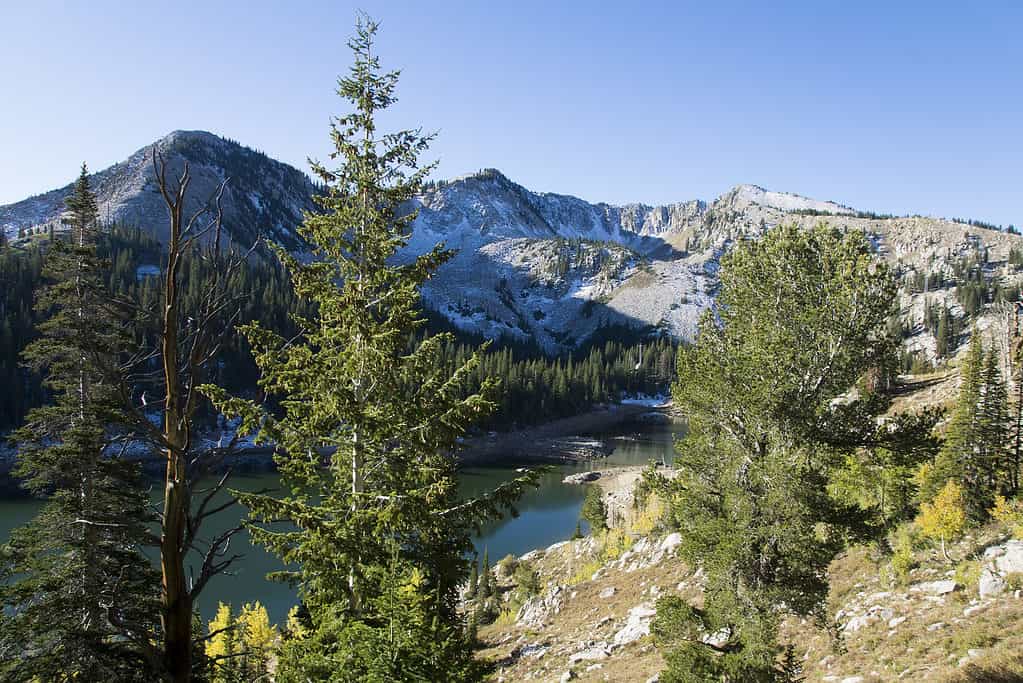
©IrinaK/Shutterstock.com
In Wyoming, the tree is often found in mid-elevations and can reach heights of 100-150 feet, although many of the larger trees have been harvested. Stands of Douglas firs today typically feature significantly smaller trees.
Native Americans used wood from the Douglas fir for fuel. They also fashioned it into tools, used its pitch to seal canoes and water containers, and utilized it for various medicinal purposes.
Its use has not diminished over time. The Douglas fir’s wood is one of the most versatile and often-used timber resources in the world and is found in everything from boats to furniture. And yes, it makes for a pretty festive Christmas tree, too.
7. Engelmann Spruce (Picea engelmannii)
Also known as the silver spruce, white spruce, and mountain spruce, the Engelmann spruce is one of the most widespread spruce trees in North America. Its straight, spire-like form dominates higher elevations in Alberta, Canada, as well as Washington, Oregon, Idaho, Montana, and, of course, Wyoming. It also proliferates the high mountains of Colorado, Utah, Nevada, and New Mexico.
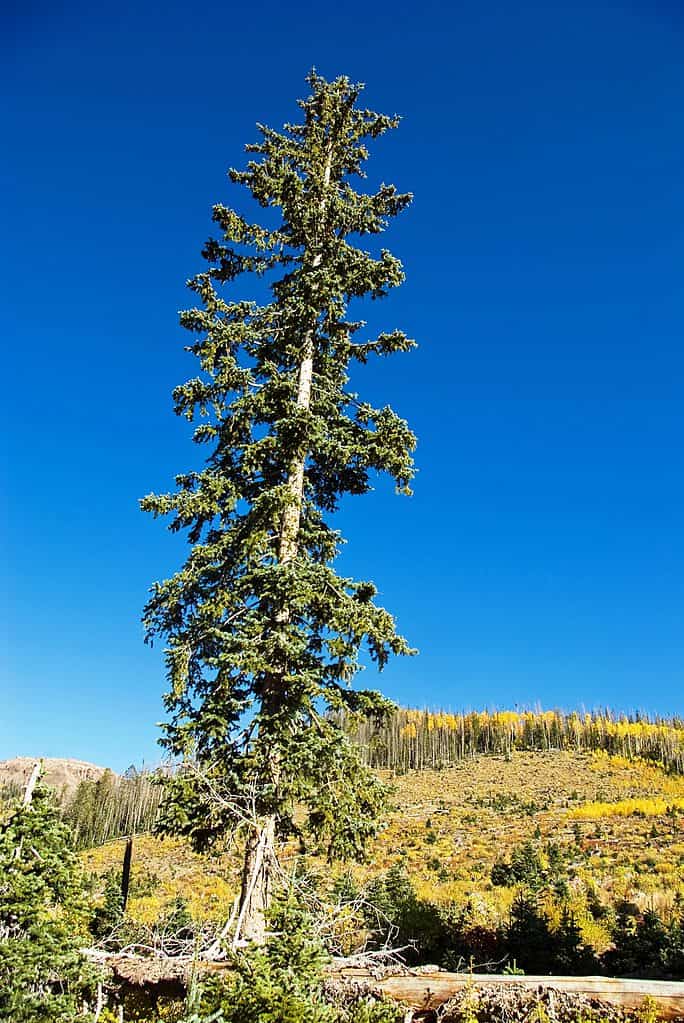
©Andrew Orlemann/Shutterstock.com
This spruce can reach well over 150 feet in height and close to 4 feet in diameter, making it one of the largest mountain conifers. The lower branches tend to droop and at least partially conceal the trunk. The scaly bark is thin and flakes into small circular plates. The bluish-green needles of the Engelmann spruce are thin, sharp, and grow in all directions, which is typical of spruce trees.
Native Americans utilized Engelmann spruce trees in a myriad of ways. The bark was used to make baskets and canoes. The roots were used to make rope. The tree was used to make medicinal poultices and the inner bark was sometimes used as a food source.
The Engelmann spruce remains a valuable resource today. It is used widely in home construction and wood products. It also had a resonant quality, making it desirable in crafting musical instruments such as violins, pianos, and guitars.
8. Rocky Mountain Juniper (Juniperus scopulorum)
Sometimes known as the Rocky Mountain red cedar or the western red cedar, the Rocky Mountain juniper is found throughout Wyoming. It’s a popular ornamental tree due to its lovely columnar, somewhat rounded shape.
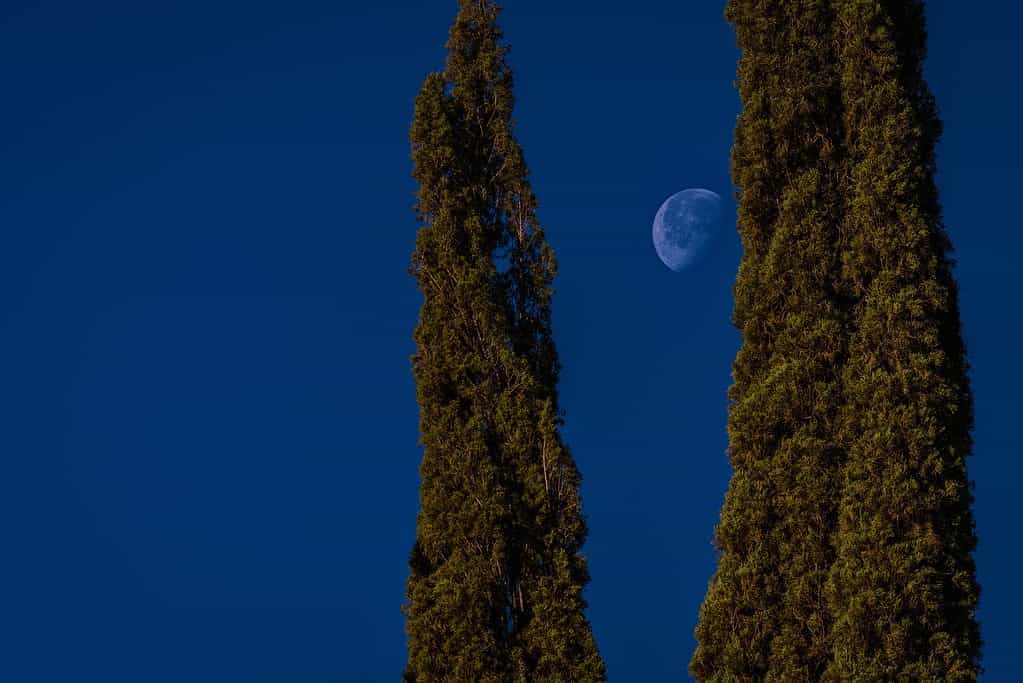
©Michael J Magee/Shutterstock.com
The Rocky Mountain juniper grows to around 40 feet tall, with a spread of about 15 feet. It is a favorite snack for deer, so the lower branches are often cropped off.
This long-lived evergreen (250-300 years) features foliage that can appear dark green, bluish-green, or light green. Berry-like cones ripen in the second year and are an important food source for native wildlife. The shedding bark is gray to reddish-brown.
The aromatic wood makes it a favorite building material for cedar chests and other ornamental crafts. It’s a very popular firewood, as well.
9. Green Ash (Fraxinus pennsylvanica)
Native to eastern Wyoming, the green ash is a popular tree in residential areas, providing shade, windbreak, and aesthetic appeal, especially when its leaves turn a golden yellow in the fall.

©Photodigitaal.nl/Shutterstock.com
The green ash is the fastest growing of all ash trees and can reach heights of 70 feet. The wood from the tree is hard and tough, making it desirable for creating everything from tools to furniture to pallets.
Highly adaptable to various soil conditions, the green ash is the most widely distributed ash tree in the United States. Unfortunately, its proliferation has been fodder for the spread of the emerald ash borer (EAB). Native to Asia, this invasive insect was first identified on U.S. soil in Michigan in 2002. It has since spread throughout much of the U.S. and into Canada. While it’s believed the EAB hasn’t reached Wyoming yet, arborists warn of the destructive potential this invader would bring to the state’s ash trees.
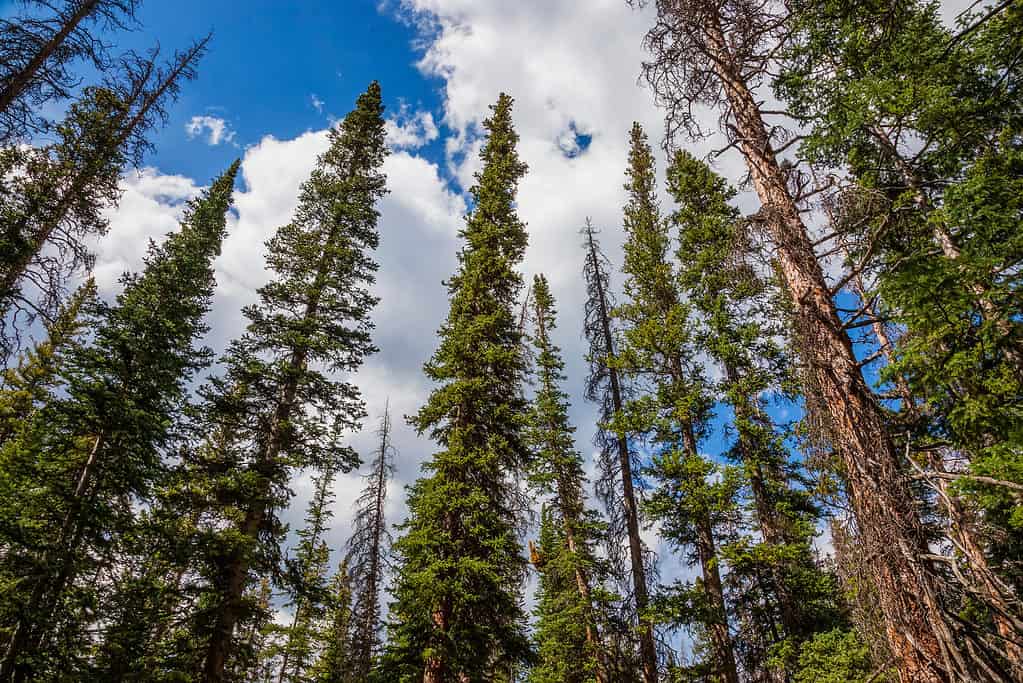
©Igor Kovalenko/Shutterstock.com
The climate in Wyoming ranges from arid desert to semiarid steppe to alpine climates. Desert regions in western Wyoming receive as little as four inches of rain per year, while some of the state’s mountainous regions can see upwards of 200 inches of snow annually. The climatological spread provides for a wonderful diversity of trees throughout the state. Get outside and enjoy them when you’re in The Cowboy State!
Up Next:
The post 9 Beautiful Trees Native to Wyoming appeared first on AZ Animals.
from Animal News, Facts, Rankings, and More! - AZ Animals https://ift.tt/KAOSrdl